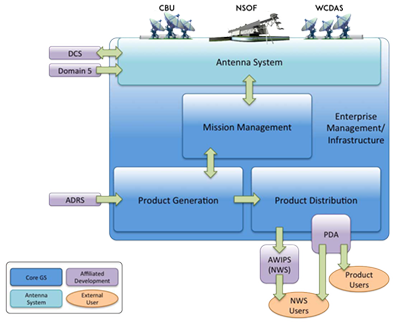Ground System: Functions
Ground Segment Functions

The key functions of the ground system are as follows:
Mission Management (MM) encompasses all functions of the spacecraft and instruments operations and health and safety. This includes space/ground communications (both uplink and downlink), GOES Rebroadcast GRB) relay and raw data processing. MM also monitors the spacecraft health and safety and commands the spacecraft and instruments. It determines the mission scheduling and planning as well as satellite orbit maintenance and control. MM is also in charge of instrument calibration and performance measurements. MM can support up to four GOES-R Series satellites.
The Product Generation (PG) creates Level 1b and Level 2+ products from L0 data provided by MM. Product generation operates on a continuous basis, meeting latency and availability requirements. PG also creates the GRB data set for transmission to GOES East and GOES West for rebroadcast to the NOAA Satellite Operations Facility (NSOF) for the generation of the L2+ data products.
The Product Distribution (PD) distributes the GOES-R Level 1b, and Level 2+ products created by the PG function through a variety of means. Users of GOES-R data, including NOAA weather forecasters, research scientists, and the general public have different means of accessing GOES-R data. PD sends data to the National Weather Service (NWS) Advanced Weather Interactive Processing System (AWIPS) for immediate use by the NWS forecast offices and to PDA for distribution to and search and retrieval by users. Additional information regarding GOES-R data access can be found in the User Readiness section of this site.
The Enterprise Management/Infrastructure (EM/IS) supports all of the above by monitoring, assessing and controlling the configuration of the operational systems, networks and communications for the GOES-R ground system, as well as providing common infrastructure and services. EM serves as the “glue” that links the MM, PG and PD functions and provides for a degree of automated control for routine system operations and failure recovery.